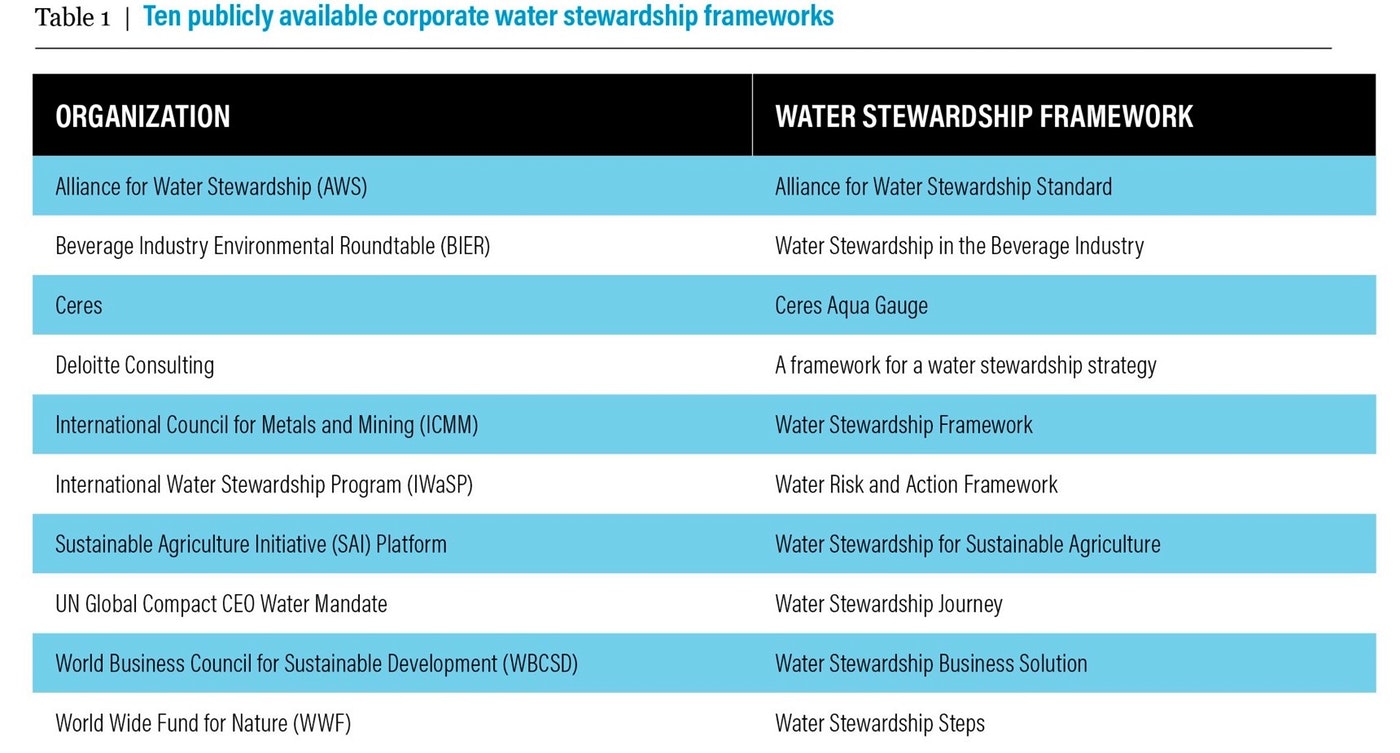There are more than 10 water stewardship frameworks meant to help companies mitigate risk and plan sustainably in a water-constrained world, but there is much more companies can be doing, write industry leaders Paul Reig and Will Sarni.
IN A WATER-STRESSED world, there’s a powerful business case for companies to manage this essential resource sustainably, engage in water stewardshipand drive collective action. As a shared resource, water provides diminished benefits to all if each user acts only in their own self-interest. Addressing today’s wicked water problems – including droughts, dwindling groundwater and failing infrastructure – will require coordinated, collective responses.
Companies across sectors, nonprofits, disclosure initiatives, industry associations and investor groups recognize this challenge and have responded with a range of water stewardship frameworks – in fact there are now more than 10 corporate water stewardship frameworks. These aim to guide companies to mitigate risk and support long-term sustainable growth in the face of growing water crises.
Despite the magnitude of the problem and plenty of guidance, 70 percent of companies disclosing to CDP Water, a nonprofit that tracks corporate action on water, have board-level oversight of water. And only 20 percent say they have a comprehensive understanding of their water risk. This discrepancy raises the question of whether the private sector is prepared to sustain business growth and create value in a world of water stress.
There are five emerging trends that inform actions companies can take to help deliver on existing water stewardship frameworks and commitments while reducing risk, boosting resilience and adding value for their stakeholders.
1. Invest in Data, Then Analyze and Disclose It
Companies require data to tell them where access to water is needed, at risk and financially relevant across their value chains, from raw material sourcing to consumer product use. Data doesn’t have to be perfect to be useful: In the absence of observed data, models and estimates will do.
But without any water data, decision-makers are putting water security, infrastructure and conservation investments at risk. Once data is collected, a company’s benefits can be doubled by disclosing it. Companies that share this information build trust and assure stakeholders that they have strategies to support long-term performance. Facebook is one of many taking the lead. To manage water efficiency, Facebook created publicly available dashboards to monitor, in real time, water use effectiveness at all their data centers worldwide.
2. Set Priorities for Internal and External Action
With access to data, companies can quickly set priorities for investments in water stewardship across their value chains, internally and externally. Documenting this information and sharing it publicly will create accountability and ensure board-level decisions result in concrete actions where they’re needed the most.
For example, the General Mills Water Policy helps ensure the ongoing strength of the business, the Mars Inc. Water Stewardship Position Statement outlines the company’s ambition to sustain growth while reducing water stress and Nestle’s Siting Framework guides the company’s siting process to create environmental, social and economic value for the business and communities.
3. Incorporate Water Into a Business Growth Strategy
In addition to improving water management, companies are increasingly incorporating water into their business strategies by developing new products and services that help solve water challenges.
For example, P&G aims to provide 1 billion consumers access to more water-efficient products, Unilever is accelerating product innovation to meet the needs of consumers in water-scarce regions and the Coca Cola Company’s Replenish Africa Initiative (RAIN) is improving access to clean water to support sustainable development in a rapidly expanding consumer market.
4. Embrace Innovation
The key to progress, particularly in times of crisis, is innovation. In the water sector, digital information networks and new technology, such as the increasing number of smart devices, are driving more efficient water use by industrial and domestic customers, improved water utility asset management and reduced need for water in agriculture. Because the benefits of sustainability-driven innovation are well known, leading companies are embracing water innovation to protect the planet and increase the bottom line:
- Levi’s developed Water<Less® to reduce water in production processes;
- The new Salesforce Tower installed the largest commercial blackwater recycling system in the U.S.;
- Microsoft is building the first net-zero water campus in Silicon Valley; and
- Apache Corporation fracks without freshwater in west Texas.
Technological innovation is critical, but it’s only the tip of the iceberg; solving water problems will also require innovative business models, financing and partnerships to sustain success.
5. Integrate Water Stewardship Into Company Culture
Companies need a culture that encourages water stewardship, removes barriers to collective accountability and accelerates response to water risk at all levels of the organization. As water crises emerge as one of the greatest threats to our global economy, so does the need for resilient organizations capable of sustaining growth and doing more with less.
For example, at General Motors, the environmental performance of facilities and manufacturing commitments (including water) is linked to the compensation of a cross-section of manufacturing employees and plant-level management. Similarly, at AB InBev, the world’s largest brewer, sustainability performance is part of senior managers’ performance objectives and remuneration. It’s only with full integration into a company’s core values and culture that the benefits of water stewardship will be fully realized.
The views expressed in this article belong to the authors and do not necessarily reflect the editorial policy of Water Deeply.
Source: https://www.newsdeeply.com/
Dear User/Visitor! Please, answer on our questions: tick off one of the positions – your answer will make us able to improve our site and make it more interesting and useful!



